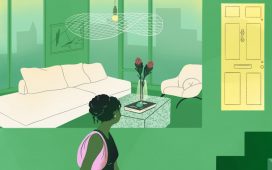Charlotte Shane was twenty-one and a graduate student when she started selling private sex shows on a Web site called Flirt4Free, in the early two-thousands. “I was a disaster on-screen: green, graceless, with a body too long and too soft,” Shane writes in “An Honest Woman,” in which she chronicles the nearly two decades she spent as a sex worker. But the fact that she might be bad at camming was also partly the point: it was a wager with herself, a way of figuring out once and for all whether she really was desirable. Her teen-age years were defined by an intense erotic longing, foiled by the sense that she was unattractive to boys: “I reasoned that if I were accepted into environments where women were expected to be sexy . . . there must be a seed of sexiness somewhere in me.” Shane’s takings would be irrefutable proof of her worth.
The money came quickly—forty-two thousand dollars in her first year and thousands more in her second—but the rate at which it flowed exposed more about the breadth of male desire than it did about Shane’s market value. Although clients might sometimes be “compelled by obvious embellishments” of orthodox femininity—blonde hair or implants—they could be just as enthusiastic about bodies that didn’t conform to this rubric. The attention and adoration was far more sincere than it was lascivious or disturbing, as sex buyers are often made out to be. After Shane began offering her clients erotic massage, and then “full service” work (meaning all-out penetrative and oral sex), her earnings and her esteem increased. She regularly came away from clients elated by her own accomplishment: “It didn’t just feel like being good at a job. It felt like being good at being a woman.”
Shane knows that her descriptions of sex work might be used as proof of the job’s perceived harms—the way it is said to subordinate women to their sexuality or commodify what should only ever be given for free—but she has little interest in sharpening the facts of her life to form a straightforward defense. Instead, Shane uses her experience as the basis for a sustained meditation on the misunderstandings that shadow male-female relations, whether paid for or not. Passages flit between her girlhood and significant events in her professional past: she recounts listening to her father loudly appraise the appearance of passing women, apparently oblivious of his capacity for hurt, and she writes about working a bachelor party where sex was a benign bonding agent and she felt “welcomed into a zone of masculine joy and fellowship.” Along with worldliness and financial security, what Shane gained from sex work was a familiarity with the male mind freed from the persistent sense that men are brutes, compelled by an “uncontrollable will to ejaculate.” Hers is a vantage on love and intimacy at once more dispassionate and more optimistic than the gloomy diagnosis of heterosexual relationships she inherited.
Shane’s writing has an exposing, unmediated style—the kind that’s formed on the Internet, where insight is reaped from the everyday. In 2008, she started a blog called Nightmare Brunette, in which she untangled the knot of her wanting to write honestly about sex work, but also wanting to have sex with men in a way that didn’t feel like work. When the blog’s readership grew too big, she launched an e-mail newsletter, “Prostitute Laundry,” in which she set her experiences of “home sex” and “work sex” side by side, revealing how little distinguished them: both could be damaging and degrading, both could be arousing and meaningful. These blog entries and e-mails have since been anthologized as books, and to read them is to be reminded of the frank, first-person essays by women which mushroomed on Web sites like Jezebel around the twenty-tens. But what makes Shane a more adept interpreter of gendered suffering and sexual autonomy than many of her contemporaries is her attunement to both the mechanics of the body and the ruses of the psyche. She catches glimpses of what is otherwise obscured, deferred, and distorted, and this gives her work a watchful and self-reliant quality that glides against the current of much millennial-feminist thought.
One target of “An Honest Woman” is the tendency among this cohort to treat straight experience as a foregone disaster. Certainly, evidence of bad male behavior accumulates in the book: there were clients who walled off sex from emotion, armoring themselves with “ego and disinterest.” This group gave credence to the “common social depiction of men as perpetually horny demons who want to put their penises in anything.” Shane also encountered the opposite: men who fused their “vulnerability and tenderness to sex,” for whom one could not be accessed without the other. And yet she never slips into what the writer Asa Seresin calls “heteropessimism”—a mood that has flourished online, in which women are encouraged to loudly announce their disappointment with men (though rarely to the extent of resigning from heterosexuality altogether). Shane is compelled by the numinous attraction that pulls her toward sexual partners, and the unguarded tenderness that certain clients feel toward her. The task of her writing is to take these appetites seriously. (She has recently spoken about men being her “muses.”)
There is much in the book about the “socially mandated trouble” between the sexes—ideas Shane assimilated as a teen-ager, “like accidentally swallowing a piece of broken glass.” Boys and girls could be friends, but relations between men and women were either erotic or adversarial. From romance novels, the Monica Lewinsky scandal, and sex-ed class, she got the impression that intercourse was especially dangerous for girls, always leading to some kind of disaster: blood, pregnancy, rape, mental breakdown, or an S.T.D. “Intimidation and harm seem foundational to, definitional of, straight sex itself,” she writes. And yet, in the folds of her grandfather’s porn magazines, Shane happened upon something that troubled this absolutist idea of female vulnerability: blissful expressions on some of the women’s faces suggested that they found pleasure in sex. Or, at the very least, that “they were fucked, and fucking didn’t harm them.” The models offered up a template of sexuality undiminished by the threat of punishment and shame that stalks women, in particular. Sex, it turned out, could do something other than shore up the couple form.
Not that Shane’s work was particularly sexy. Although she writes with real exuberance about clients with whom she shared a “wordless chemistry” and paid encounters that had the condensed intensity of a psychedelic trip, tedium is the prevailing feature. The job requires much mollifying, flattering, feigning interest—skills women instinctively acquire as “designated emotional custodians” of the species. Shane was particularly good at performing “a certain blankness,” the practiced dissociation of emptying herself out to be filled with whatever fantasy or need the client decants into her. There were the hobbyists who collected encounters with sex workers like rare vinyl; the fetishists who came with hyperspecific role-play requests too rarely indulged; and the romantics who wanted an attractive conversationalist to take to the Boston Symphony.
This is the kind of high-paid work that gets called “private escorting” or “the girlfriend experience,” but, as Shane writes in an essay from 2015, she prefers “prostitute,” because what she sold was the “promise of heterosexual, penetrative sex,” even if much of the job was spent clothed and engaged in conversation. Her point is to adopt an “unapologetic and unashamed” position toward a job veneered in euphemisms, for reasons of both legality and stigma. Even the term “sex worker,” which has tilted debates about paid sex toward workers’ rights, can sometimes swallow its specificity, as if “there really is something bad and wrong about charging money to engage directly with someone else’s genitals.”
“Men,” Shane thinks, “have an easier time respecting prostitutes than women who hate prostitutes care to admit.” There were, of course, clients who pushed the boundaries of what was agreed on with her, and whom she “blacklisted with abandon.” She can remember only one, though, whose disregard for her was so profound that he kept his eyes fixed on the TV as she fellated him. “I might as well have been a Roomba gliding over his dick.” To be treated like an object is also what made Webcamming so gruelling. Men regularly requested that Shane penetrate herself with a stripper heel, apparently oblivious of the idea that women have “nerve endings and pain receptors and intimate vascular tissues that weren’t hard to tear.” In real life, the majority of her clients were courteous, even “decent.” Whether or not they’re paying, people tend to want to at least feel like they’re fucking a sensate person and maybe even giving them pleasure—though Shane admits that simulating climax was perhaps the part of the job she resented most, since her orgasm “mattered not because of how good it would feel to me but because of how good it would feel to them.”








